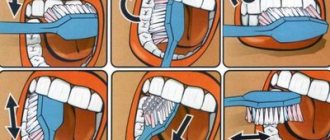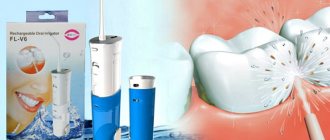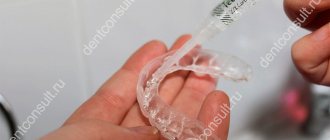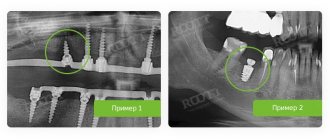At all stages on the way to growing up, a child’s body goes through a lot of crises and undergoes many changes. Experts call the appearance of the first teeth one of the global changes. This is a sign that soon the baby will begin to switch to a different type of food and begin to learn to care for his teeth on his own.
Like any fundamental change, the teething of the first teeth is shrouded in myths and folk “advice,” fears and prejudices. However, not all of them are groundless. Serious changes in a child’s body are noticeable even to inexperienced parents; the teething process can be predicted and greatly facilitated.
Experts identify a number of main symptoms of the appearance of first molars, namely:
- baby's irritability;
- sleep disorders;
- swelling, redness of the gums in the place where the tooth is cut;
- disturbances of appetite, attempts to completely refuse to eat due to the fact that this process causes discomfort to the child;
- increased salivation (and, as a result, a rash on the chin);
- watery eyes;
- the child’s attempts to constantly gnaw or bite something to relieve itching in the gums.
Additional symptoms of teething include:
- slight and short-term increase in body temperature;
- small hematomas in the place where a new tooth plans to appear;
- child's cough (also short-term);
- loose stools (occasional);
- vomiting (clean, due to the fact that the baby swallowed saliva);
- runny nose.
If additional symptoms appear complexly and for a long time, this is a reason to contact a specialist!
Many doctors say that a runny nose when a child’s first baby teeth erupt is absolutely normal. It can manifest itself for several reasons:
- irritation of the nasopharyngeal mucosa;
- allergic reactions;
- mild colds due to decreased body immunity;
- a large volume of saliva that enters the nose.
Despite the fact that teething in general is not a very pleasant process, both for the child and for the parents, the appearance of a runny nose during this period greatly aggravates the situation. The baby does not understand what is happening to him, becomes even more capricious and restless, he needs to pay even more attention, and rinsing and cleansing of the nose is also added to the daily procedures. But the good news is that a runny nose during teething is a normal physiological reaction. In addition, it helps to notice the appearance of a tooth and goes away within 3 days.
Runny nose in a baby during teething: main causes
Almost everyone will have painful teething, this situation cannot be avoided. But knowing the symptoms and the reasons for their appearance, parents can make life much easier during this difficult period for both themselves and their baby.
Let's take a closer look at why many children also develop a runny nose when their first teeth appear.
The mucous membranes of the nose and mouth are located quite close. Due to the fact that mild inflammation begins in the mouth, the nasal mucosa is also irritated. The body reacts to this instantly, starting to produce phlegm (“snot”) in order to calm the irritation or get rid of what may be causing it.
In addition, increased irritation of the nasal mucosa occurs due to the fact that blood enters both the nose and mouth through the same arteries. Blood circulation in the oral cavity during teething becomes more active, and the same processes occur in the nasal mucosa. And the more active the blood circulation, the more mucus the mucosal glands will produce.
A runny nose may occur due to a mild cold. It is during the period when the first teeth are cut that the first complementary foods are introduced, the dose of breast milk is reduced, and the body undergoes restructuring. Also, the baby constantly tries to chew something to relieve itching from the gums, and the path for viruses and microbes into the small body is open. Fortunately, the baby has enough resources to fight off a cold. A slight runny nose is its residual effects.
It is precisely because of reduced immunity and changes in the child’s eating behavior that a runny nose can also signal allergic reactions. At the same time, it is important to monitor whether the child has any other manifestations of allergies. You should be alerted to a rash, itching, and redness of the mucous membranes of the eyes.
If the baby remains active during the teething period, it is likely that due to his active movements, part of the saliva, which is secreted more than abundantly during this period, ends up in the nose. And it comes out of it in the form of transparent, light snot.
Stages of a runny nose
There are three stages of a runny nose:
- 1st – dry stage. Complaints of a burning sensation in the nose appear, frequent uncontrollable sneezing begins, which is accompanied by eye irritation and lacrimation. A person feels his nose become stuffy, his breathing becomes impaired and his sense of smell disappears.
- 2nd – wet stage. The mucous membrane is covered with serous secretions. They are transparent and quite abundant. A runny nose at this stage leads to swelling inside the nasal cavity. Air does not pass through the nasal passages or passes through with difficulty, as a result of which a change in voice is observed, the person speaks “through the nose.”
- 3rd – stage of mucopurulent discharge. First, a yellow secretion begins to be produced. It is much thicker than the initial transparent discharge. When a bacterial infection penetrates, the discharge changes color to yellow-green, which indicates the presence of pus.
You may also be interested in
CHILDHOOD
Finger wipes from 0 to 3 years ASEPTA BABY
For gentle oral hygiene of babies and massage of gums during the eruption of the first teeth
More about the product
CHILDHOOD
Children's gel toothpaste from 0 to 3 years ASEPTA BABY
Designed for gentle care of baby's gums and baby teeth
More about the product
Don't rush with complementary foods
As you know, a child’s first molars begin to appear at the age of 6 months. This period in life is also associated with a change in eating habits. It is important that during this period complementary foods are not introduced abruptly or in large quantities - this is a stressful situation for the child, which will provoke a decrease in immunity.
In addition, at the same time, a change in “antibodies” occurs in the baby’s body. While in the womb and in the first months of life, the child’s immune system “works” with the help of antibodies from the mother’s body. And it is at six months that “maternal” antibodies begin to be replaced by “own-produced” antibodies, and the fragile immune system may not cope on its own.
If your baby's teething process is painful, delay introducing solid foods. Remember that breast milk meets 90% of a baby's needs up to the age of 1 year.
Monitor air humidity and take walks
If several teeth are cut at the same time or one by one, then a runny nose can last for a week. At the same time, if the color of the discharge does not acquire a pathological shade characteristic of infectious diseases, there is no need to be overly nervous about this. If there is no fever and the child is alert, he can be bathed.
If you have a runny nose due to the first teeth, fresh air and maintaining normal humidity in the room help. Frequent airing and walks in nature will help ease this period for the baby.
Use medications only when absolutely necessary
In such situations, taking strong medications should be avoided. Including those that affect vascular tone. The small body quickly gets used to them and in the future will not be able to cope with breathing without the constant use of medications. In critical cases, the use of vasoconstrictor drugs is allowed for 6 days, no more. In addition, they must be with a strictly “children’s” dosage of the active substance and used in the dosage prescribed by the doctor.
To relieve general pain syndromes, children are recommended to be given anti-inflammatory and antipyretic drugs. They will help get rid of unpleasant sensations, but, alas, will not affect the abundance of phlegm.
Cleaning baby's nose
You can remove mucus yourself, using baby syringes or nasal aspirators, which are produced, for example, in the shape of funny animals and will not scare the baby; on the contrary, they will make the procedure of cleaning the nose fun.
In addition, syringes and nasal aspirators have different operating principles. If, with the help of the first, a certain solution is poured into the spout, and then it is removed from the nasal sinus, then nasal aspirators gently suck out excess mucus without causing the child any unpleasant sensations. They are mechanical and electronic.
In addition, to clean the sinuses, you can use thick cotton or gauze swabs or special wet baby wipes rolled into thick soft tubes.
You need to get rid of snot several times a day, in a way convenient for you.
However, experts do not recommend using sprays to clean the nose, since in children they can cause spasms of the vocal cords or simply scare the child.
At the same time, while getting rid of mucus from one nasal sinus, the second one must be carefully closed. It is better to clean the nose periodically so that the snot does not irritate the throat or get into the bronchi, maxillary sinuses or ears.
The cleansing process may not always be pleasant. Delicate mucous membranes will react sharply to it - with coughing reactions or even nausea. But after 3-4 procedures, if there were any negative reactions, they will disappear.
Basic rules for dealing with a runny nose during teething in a baby
The process of the appearance of new incisors and molars is not always accompanied by a runny nose. For many parents, this process can go unnoticed. Experts have come up with several “general” rules, the observance of which is useful for the child as a whole, but during such a runny nose it will make life much easier for both the baby and adults:
- Walks in the open air. The more time a child spends outside, in comfortable conditions, the easier it will be for him to breathe. Even in the cleanest house there is dust and similar irritants that aggravate a child's runny nose.
- The air temperature in the house should not be lower than +17 or higher than +22.
- The air humidity in the children's room should not be lower than 55% or higher than 75%.
- Gently remove mucus from the baby's nose. Make sure that the mucous surfaces are not overdried.
- Monitor the type of discharge. If they are opaque and thick, this is a reason to worry.
- Give the child a lot to drink to compensate for the loss of moisture (excessive tears, snot, salivation reduces the level of water in the body, and this can lead to drying out of the mucous membranes, an increase in temperature and the onset of inflammatory processes).
- Keep calm. If a runny nose is not a symptom of a disease, then it will go away on its own. You need to come to terms with it and only make this period as easy as possible for the baby.
Prevention of runny nose and cough during teething in a child
There are no specific measures to prevent these unpleasant symptoms. However, following general hygiene and feeding recommendations will help keep your baby's body healthy and able to resist infection.
Recommended:
- Exclusive breastfeeding up to 6 months.
- If the child is bottle-fed, it is also not recommended to introduce complementary foods before six months.
- Gradual introduction of complementary foods focusing on the baby's nutritional interest.
- Maintaining the child’s personal hygiene, including oral hygiene. Asepta Baby finger wipes are great for this, helping to remove food debris and plaque from the baby’s gums and teeth.
- Correct daily routine, walks in the fresh air, cleanliness of the room and maintaining an optimal microclimate.
These rules will help support the child’s immunity, so that he can better cope with difficult trials for him, such as teething.
We hope your baby's teething process is painless and you get a good night's sleep. And if unpleasant sensations still bother your baby, ASEPTA BABY finger wipes for 0 to 3 years will help provide a gentle massage and relieve gum pain. Impregnation with plant extracts prevents inflammation and allows you to maintain the acid-base balance of the oral cavity.
Increased saliva production
When the body begins to prepare for teething, the baby increases blood supply and circulation to the mucous membranes and gums, which irritate the teeth that are about to break through. This includes increased blood circulation in the area of the salivary glands and nasopharynx, due to which salivary secretions begin to appear in excess quantities in the child’s mouth. It is also present in the nose, and is often mistaken by parents for snot.
One of the signs of teething is increased salivation.
Saliva, among other things, is the body’s protector from bacterial attack. In young children, it does not yet possess all the enzymes that help fight harmful microorganisms, but, nevertheless, it is already able to secrete the enzyme lysozyme in small quantities, which has an anti-inflammatory and antibacterial effect. It is precisely this that is necessary for the natural fight against the inflammatory process on the mucous membrane, without which not a single tooth erupts.
Excessive amounts of saliva accumulate in the baby’s mouth, some of the saliva flows out, and some enters the gastrointestinal tract (which is why the child may experience loose stools and diarrhea). If the baby is in a lying position, then saliva enters the nasopharynx, flows down the back wall of the throat, causing irritation, and the body turns on protective mechanisms, which is why the cough and runny nose so familiar to everyone appears. But if the cause of cough and snot is determined precisely, i.e. It was drool that was to blame, so don’t give your babies expectorants; 3-4 days after teething, such symptoms will go away on their own.
How to relieve coughing attacks?
If the cause of the cough is teething, no treatment is required.
The main medicine for the baby during this period is the care and attention of the mother and father. While the baby is teething, you need to continue to walk with him, play and entertain him, try to distract him from the pain as much as possible
Of course, you should also try to reduce the pain that causes the cough. To do this, you can offer your baby special cooled teethers, which are made of safe rubber or silicone.
They can be purchased in pharmacies or children's stores in the departments for children of the first year of life. These teethers come in various shapes and colors, which is sure to attract the baby's attention. You can also do a light massage of the gums, gently pressing on them.
Cleaning and rinsing the nose from mucus
Most parents are concerned about how to deal with a strong cough in their baby. In fact, it is not the cough that needs to be treated, but the runny nose, since it is this that is the source of the problem. To do this, you need to purchase an aspirator or take a syringe, and then use it to free the baby’s nose from mucus.
Please note that when using an aspirator, the most important thing is not to scare the child.
In addition, it is necessary to rinse the spout with saline solution. You can buy saline solution at the pharmacy or prepare it at home
This aspirator can clear mucus from your nose.
on one's own. To make it, you need to dissolve a teaspoon of salt in one liter of boiled water.
You can also use medical products made from sea water, such as Aquapor, Aquamaris and others. It is worth noting that using sea water helps relieve swelling. Doctors advise rinsing your nose about 3-4 times a day. This procedure will help the baby breathe through the nose, which can help stop the cough.
Please note that sometimes pediatricians may recommend immunostimulating drugs for the baby in order to increase the body's defenses during teething. If the baby is bothered by severe pain, then to eliminate it it is worth giving preference to pharmaceutical drugs
There are a large number of drops, syrups, ointments, gels and rectal suppositories that are aimed at pain relief. The most popular are gels, as they are easy to use and give quick results (they seem to freeze the pain)
If the baby is bothered by severe pain, then to eliminate it it is worth giving preference to pharmaceutical drugs. There are a large number of drops, syrups, ointments, gels and rectal suppositories that are aimed at pain relief. The most popular are gels, as they are easy to use and give quick results (they seem to freeze the pain).
A child in his first year of life sleeps quite a lot. Therefore, he needs to equip his sleeping place as carefully as possible. Firstly, it is better to place the baby on its side rather than on its back. Secondly, you should slightly raise the baby's head by placing a pillow under it.
Traditional medicine to protect the baby
There are also folk methods that will help relieve a cough attack. The safest and most proven are:
- liquid honey helps get rid of redness, itching and swelling of the gums, but it can only be used if there is no allergic reaction;
- regularly ventilate the room in which the child is located, monitor the humidity and temperature in the room;
- against a runny nose, you can use drops containing natural oils, such as fir or eucalyptus;
- drinking plenty of fluids.
During this period, parents should minimize other stress in the child’s life, for example, weaning or the transition to a new daily routine is best postponed until better times.
Thus, the eruption of the first teeth is a natural process that occurs between 4 and 9 months. At this time, the baby may become restless, irritable, capricious, refuse to eat, and may also develop a fever, cough or runny nose. These are all symptoms of rapid eruption of baby teeth.
However, it is worth paying attention that if parents notice such symptoms in their baby for more than three days, this is a reason to consult a doctor









